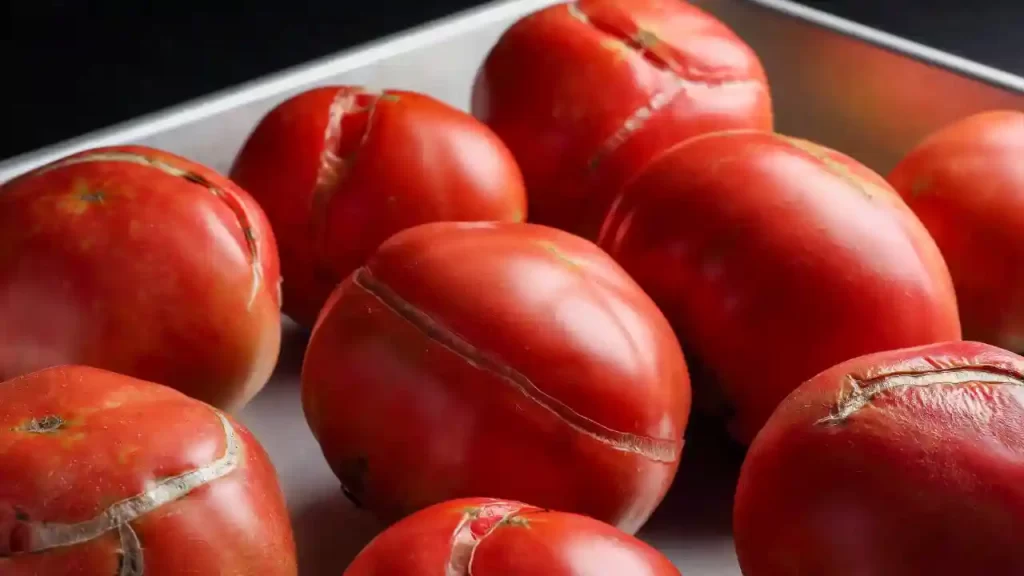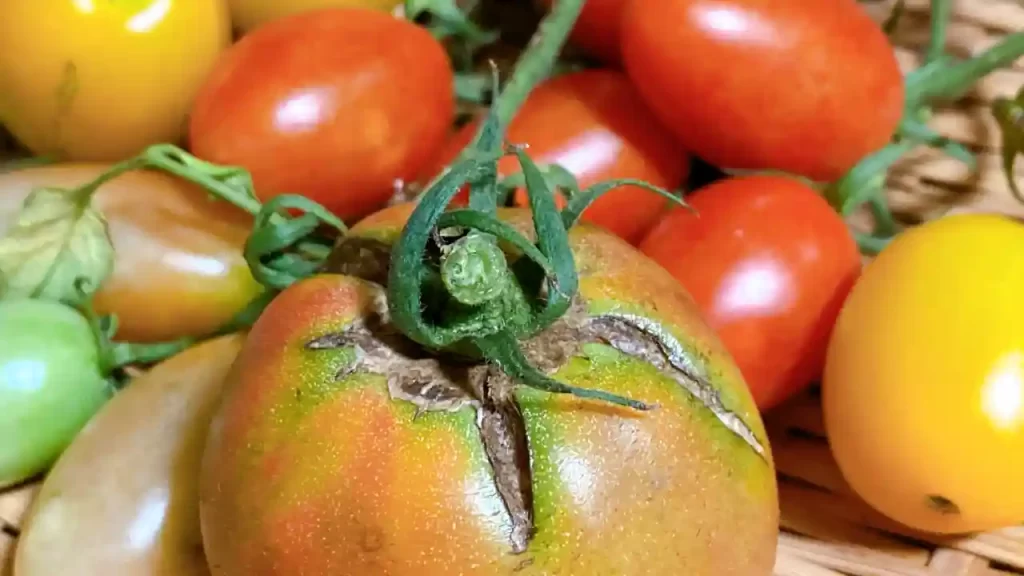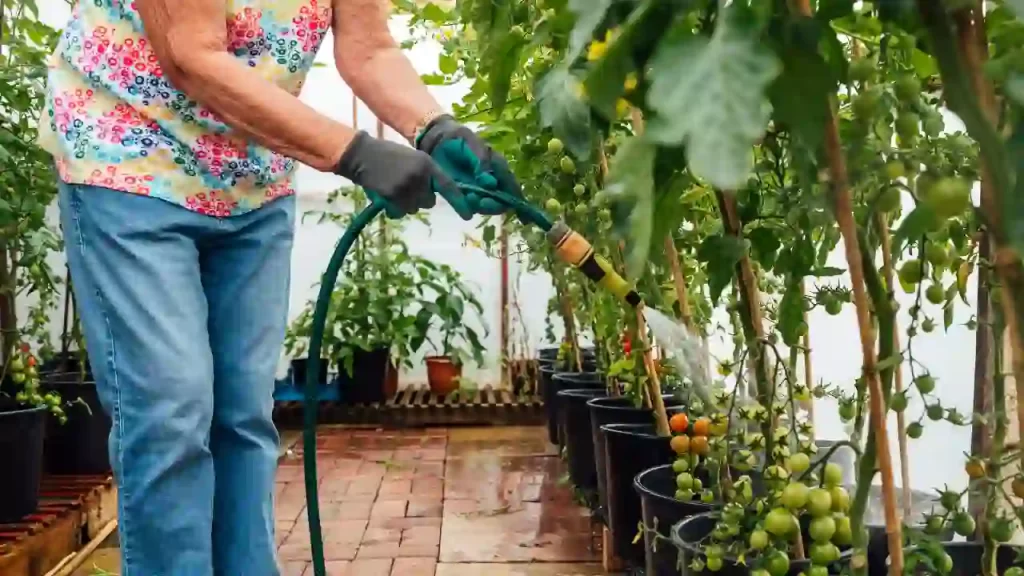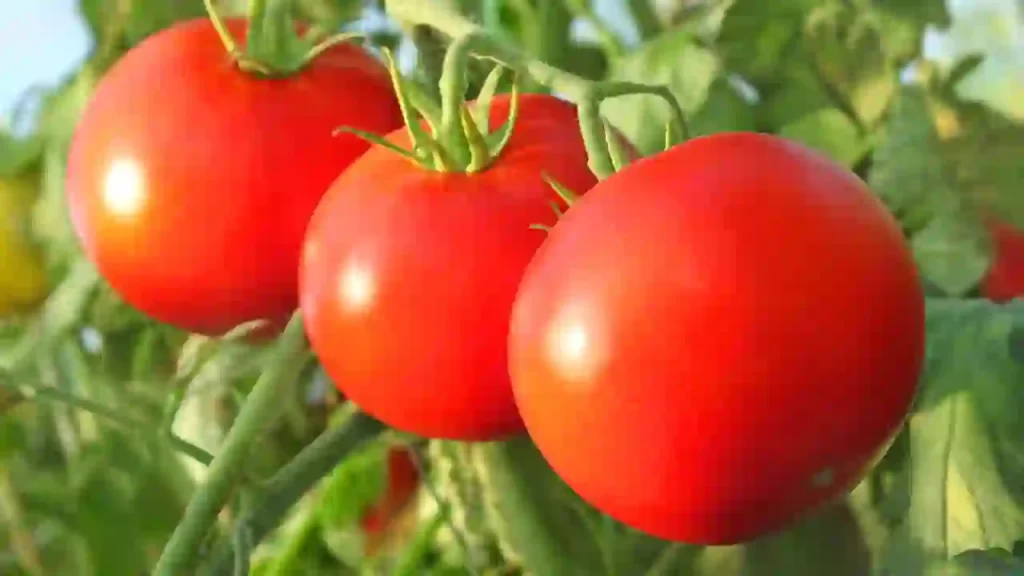Tomatoes split due to a sudden change in the water supply to the plant. Unfortunately, there is no treatment to cure tomato splitting. But obviously, you can take preventive measures to avoid the situation and prevent tomatoes from splitting.
In short, Rapid fluctuations in soil moisture levels can cause fruits, such as tomatoes, to expand faster than the skin can grow, resulting in split tomato fruit. These cracks can take one of two forms: radial cracking, which appears as vertical splits along the sides of the fruit, and is the more severe of the two types of damage.
Water consistently, maintain adequate soil moisture by mulching around the plant area, and choose a variety of tomatoes resistant to split to avoid this.
I have seen the splitting of tomato fruits mainly after heavy rain.
Why Do Tomato Split?

Inconsistent water supply to the tomato plant results in split or cracked tomatoes. Heavy rainfall followed by dry weather is the main reason behind the splitting and cracking in tomatoes.
When tomatoes speed up their growth, the flesh inside them grows more rapidly than the skin, resulting in tomatoes cracking. The tomato pulp comes outside and sometimes may result in rotting also.
We cannot ignore the uneven irrigation, high nitrogen content soil, and lack of calcium, as they are also the reasons for split tomatoes. But pests are certainly not the reason for splitting tomatoes.
So there’s no danger of spreading the issue to other plants. Both red and green tomatoes can get affected, but ripened tomatoes are more prone to split.
Cracking happens in Radial Cracking and concentric cracking patterns. Radial Cracking, i.e., vertical Cracking, is more dangerous as it attracts many diseases.
So the best option is to pluck and use them instantly and dispose of all the smelly and already rotten tomatoes.
Concentric cracking looks like a spot or ring, and the flesh of the tomato is not exposed. So it is less contagious to diseases. You can let these tomatoes ripen on the vines until the flesh of the tomato is exposed.
Points to remember:
- Water inconsistency is the main reason for splitting tomatoes.
- Both green and ripened tomatoes can split or crack, but ripened tomatoes are more prone to this.
- If the flesh of split tomatoes is exposed, it should be harvested as soon as possible to reduce the risk of disease and should be used if it is not already rotten and smells pungy and sour.
- You can trim the affected areas of tomatoes and use them as sauces, salsas, or other items.
- Tomatoes cracked in concentric patterns can ripen on the vines as the flesh is not exposed. Keep an eye on it; as and when it starts exposing the flesh, harvest them.
Types of Cracking in Tomatoes

Tomatoes split into two patterns: vertical and concentric cracking patterns.
Vertical Cracking
Vertical Cracking is visible from the top to the bottom of the fruit and is also called radial cracking. When tomatoes split in this pattern, the chances of rotting, getting infected, and attracting insects are more as the flesh of the fruit is more exposed.
Therefore, it is always best to harvest these types of tomatoes and utilize them as soon as possible. Inspect if any tomatoes smell sour or rotten; if so, discard them off.
Concentric Cracking
Concentric Cracking appears like a ring and forms a circle on the top stem of the tomatoes. Generally, they do not result in exposing the fruit’s flesh; hence, it is less prone to disease. So you can let them ripen on the vines.
But always keep an eye on these types of tomatoes while they grow; if they attract insects or rot, harvest them instantly.
But the harsh truth is that they last only a short time and start rotting very quickly, and the taste of these tomatoes is not as good as regular tomatoes. So inspect for any insects in the fruit before using them.
7 Reasons For Cracking and Splitting Of Tomatoes on the Vine and How To Prevent

Splitting and Cracking of tomatoes occur due to various reasons like improper moisture in the soil, inconsistent watering, less fertile soil, and many more.
If you do not choose the split-resistant variety of tomatoes or harvest them too late, it might also be the reason for fruit cracking and splitting.
Water Fluctuations
Inconsistent watering is one of the main reasons for tomatoes splitting or cracking . Heavy rain is followed by dry weather resulting in a split or cracked tomatoes.
Ninety-five percent of tomato fruit is water, and due to the sudden heavy supply of water, they crack. As a result, the flesh of the tomatoes grows more rapidly than its skin, and the skin bursts.
To prevent this issue, I always do mulching to maintain the soil’s limited moisture and good soil drainage facilities. Sometimes I use an irrigation timer to keep consistent watering and maintain water fluctuation.
Overwatering Before Harvest

Overwatering before harvesting tomatoes also creates premature splitting issues in almost-ripe fruit. In addition, overwatering your tomato plants also invites various diseases and root rot. Therefore, it is very important to check the soil moisture before watering.
Flooding your tomato plant with excess water results in swelling and cracking. Overwatered tomatoes produce fewer fruits. These tomatoes are generally flavorless and taste watery.
Deep your finger in the soil; if the soil is dry up to 1 inch, it is the right time to water your plant. Avoid watering your plant on the day of harvesting.
The best time to harvest is either in the morning or evening. The air during this time is humid and sugar concentrated.
Calcium Deficiency
Lack of calcium in tomato plants leads to Blossom End Rot, which causes black water and wounds in tomatoes. Calcium is the main reason behind ripening and uptaking water up taking.
Calcium solution should be sprayed 2-3 times weekly on the foliage to reduce the splitting issues in the tomatoes.
To completely eliminate the problem, organic calcium fertilizers like eggshell or oyster shell should be used in the soil 4-6″ deep while planting tomatoes to make the soil calcium rich.
Poorly Drained Soil
Waterlogging in the tomato plant’s soil can damage the plant and, in the future, split tomatoes. Tomatoes can be grown healthy only if the soil is well drained. In addition, tomatoes can breathe properly only in adequately drained soil.
When the roots are socked in poorly drained soil, they need to be more efficient in delivering proper water and nutrients to the plants, which attracts various diseases.
You can use good quality compost to overcome the situation. Also, prepare rich soil mix with rotted manure, peat moss, or shaded leaf mulch and avoid overwatering your plant to prevent this issue in the future.
Tillage can create more water logging issues, so you must avoid it as much as possible.
Over-Ripening

Vine Ripened Tomatoes are more tasty and delicious than green-picked and indoor-ripened tomatoes. However, if you won’t pluck your tomatoes on time, it is more likely to be split and cracked.
Due to the concentrated sugar, the flesh of tomatoes is more swollen inside, and when there is heavy rain or prolonged irrigation, they split very fast if not picked up on time.
It is an open invitation to pests, insects, and various diseases, which can even cause the rotting of the fruit.
So it is best to pluck the little under-ripe tomatoes to escape from cracked tomatoes. Using this process before rain can save your tomatoes from splitting.
Ethylene is responsible for the ripening of tomatoes. So the best way to promote ethylene is to keep a bunch of bananas while ripening tomatoes indoors.
Tomato Plant Variety Selection
If you face tomato splitting problems in every season, you must check the variety you have planted. Always choose split-resistant varieties of tomatoes.
Avoid Beefsteak and Cherokee Purple tomatoes, as they are more prone to splitting and cracking. In addition, they split easily when they come in contact with hot weather with so much water in the soil.
Jetstar, Roma, and Prudence Purple are some examples of split-resistant medium-sized tomatoes. In addition, some small cherry tomatoes like Black Cherry, Gold Nugget, and Sun gold are also split-resistant.
Exposed Fruit
Tomatoes are designed in such a way that they would grow healthy only if they are shaded with the leaves of the plant. So over pruning of tomato leaves also causes significant issues like splitting and even sun scalding.
When tomatoes are overly exposed to sunlight, spotting and uneven ripening occur, leading to the splitting of tomatoes.
To overcome the situation, create artificial shade with clothes, avoid over-pruning leaves, and prevent tomatoes from overexposure to sunlight. In the worst scenario, you can also pluck the tomatoes early to save them.
What to Do if Your Tomatoes Split?
Split tomatoes attract insects which in turn spread various diseases. As soon as you see the split or cracked tomatoes, pluck them at the earliest.
You can trim the lousy part of split tomatoes and use them to make sauces and salsas and cook your favorite fresh recipe.
However, only store these tomatoes for a short time as they attract insects easily. Before using these tomatoes, please inspect if they are rotten or have pungent or sour smell.
Final Thoughts
Always ensure the preventive measures discussed above, and you will never face this issue. Consistently Watering one inch in the base of the plant every week would give you the best result. It is best to create mulching with straw around the plant to maintain adequate moisture in the soil.
You can also arrange for good drainage soil and Cultivate split-tolerant varieties of tomatoes.
Even after putting in so much effort, if still, your tomatoes are splitting, harvest them before time and let them ripen indoors.
Frequently Asked Questions
Can You Eat Split Tomatoes?
Split or cracked tomatoes are not good to see, but freshly picked split tomatoes are safe to eat unless they have already attracted insects. However, check thoroughly before eating them, as the exposed flesh is prone to pests and insects and should also not smell sour.
Tomatoes with white, brown, or black spots are also safe to eat. You need to trim the affected part and finish the split tomatoes as soon as possible, as they begin to rot early.
Does over-watering cause tomatoes to split?
There are better options than over-watering tomato plants, as this is one of the main reasons for splitting tomatoes.
Always check the moisture level of your soil before irrigation, or else you will end up flooding your tomato plants which they don’t even require.
This also results in the rotting of tomatoes, making them more prone to disease and premature splitting, even in ripe tomatoes.
Recent Posts
Are you ready to plant tomatoes for the best tomato harvest of your life? It all starts with getting the fertilizer right! Fertilizing tomatoes can seem daunting, but when done correctly, it’s...
9 Reasons Why Your Tomato Plants Wilting and How To Fix This!
When the gardeners see their lovely and precious tomato plants wilted, they become hopeless, sad, and impatient. But the situation can often be reversed with proper care and adopting a few good...
